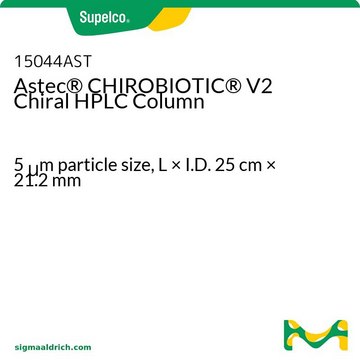53123AST
Astec® CLC-L Chiral (5 μm) HPLC Columns
L × I.D. 15 cm × 4.6 mm, HPLC Column
Synonyme(s) :
Liquid Chromatography Chiral Column
About This Item
Produits recommandés
Nom du produit
Astec® CLC-L Chiral HPLC Column, 5 μm particle size, L × I.D. 15 cm × 4.6 mm
Matériaux
stainless steel column
Agence
suitable for USP L32
Gamme de produits
Astec®
Conditionnement
pkg of 1 ea
Fabricant/nom de marque
Astec®
Paramètres
0-50 °C temperature
172 bar pressure (2500 psi)
Technique(s)
HPLC: suitable
L × D.I.
15 cm × 4.6 mm
Matrice
fully porous particle
Groupe de la matrice active
chiral bidentate ligand (L-form), requires 5 mM CuSO4 phase
Taille des particules
5 μm
Dimension de pores
100 Å
pH de fonctionnement
3.5-7
Technique de séparation
chiral
Catégories apparentées
Description générale
Features:
- Separates α-hydroxy carboxylic acids, amino acids and other α-bifunctional compounds
- High selectivity with simple mobile phases
- Copper complex gives strong UV 254 nm signal
- Simple reversal of elution order, CLC-L vs. CLC-D
- Excellent reproducibility
(1) Davankov, V. A.; Rogozhin, S. V. Ligand chromatography as a novel method for the investigation of mixed complexes: Stereoselective effects in a-amino acid copper(II) complexes. J. Chrom. A. 1971, 60, 284-312.
Informations légales
Faites votre choix parmi les versions les plus récentes :
Déjà en possession de ce produit ?
Retrouvez la documentation relative aux produits que vous avez récemment achetés dans la Bibliothèque de documents.
Protocoles
Separation of DL-Lactic acid, ~90% (T)
Contenu apparenté
Astec CLC Copper Ligand Exchange Chiral HPLC Columns. The Astec CLC phases are based on coupling an enantiomeric form of an amine to a proprietary Astec derivative to create an appropriate distance for copper coupling.
Chromatograms
application for HPLCapplication for HPLCapplication for HPLCapplication for HPLCNotre équipe de scientifiques dispose d'une expérience dans tous les secteurs de la recherche, notamment en sciences de la vie, science des matériaux, synthèse chimique, chromatographie, analyse et dans de nombreux autres domaines..
Contacter notre Service technique

